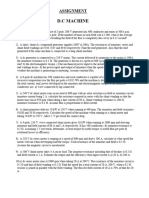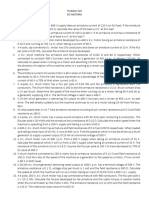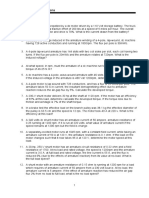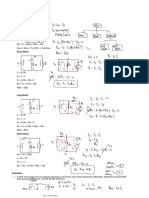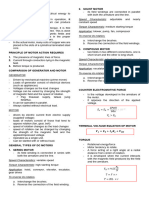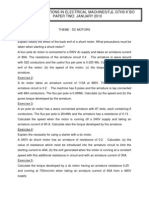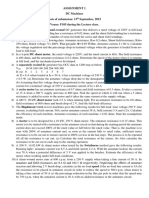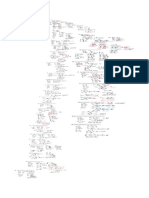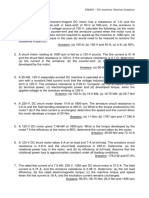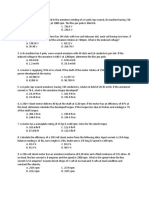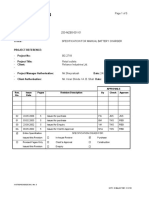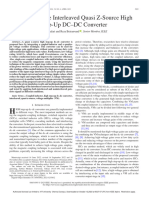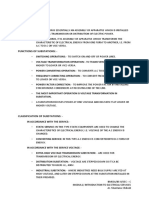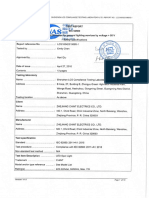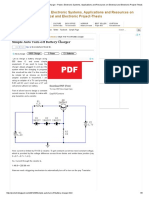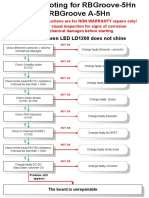Department of Energy Science and Engineering
ESL262 Electrical Mechanics
Tutorial 2: DC Machines
1. The armature of a 4 pole lap wound dc machine has a core length =30cm,
diameter =40cm, total conductors =500, speed =1200rpm, and current =20A.
For an average flux density of 0.5T, find the electromagnetic (or gross
mechanical) power developed and the internal torque.
2. A 6 pole DC machine has 300 conductors and each conductor is capable of
carrying 80A without excessive temperature rise. The flux per pole is 0.015Wb
and the machine is driven at 1800rpm.
Compute the total current, EMF power developed in the armature and
electromagnetic torque, if the armature conductors are (a) Wave connected and
(b) Lap connected.
3. A 6 pole lap wound DC generator has 240 coils of 2 turns each. Resistance of
one turn is 0.03Ω. the armature is 50cm long and 40cm diameter. Airgap flux
density of 0.6T is uniform over pole shoe. Each pole subtends an angle of 40o
mechanical. For armature speed of 1200rpm, find (a) generated EMF at no load
(b) terminal voltage at full load armature current of 40A.
4. A 230V dc shunt machine has armature circuit resistance (including brushes) of
0.5Ω and field resistance of 115 Ω. If this machine is connected to 230V supply
mains, find the ratio of speed as a generator to the speed as a motor. The line
current in each case is 40A.
5. A 250V,10kw dc shunt generator has 1400 turns on each pole. At rated speed a
shunt field current of 2A produces a no load voltage of 250V, but at rated load
the same load voltage of 250V can be produced by a field current of 2.2A. It is
required not to change the field current for maintaining the load voltage constant,
but add a series field winding. Calculate the number of series filed turns per pole
required for long shunt connection.
6. A 230V 10kw dc shunt generator gave the following data for the magnetization
curve at rated speed of 1500rpm.
If amp 0 0.2 0.4 0.6 1.00 1.40 1.80 2.00
Ea volt 6 40 80 120 194 246 269 274
The resistance of the shunt filed and armature circuit are 184 Ω and 0.433 Ω
respectively. At the rated load and speed a field current of 1.7A is required to
maintain rated terminal voltage. Fine the demagnetization effect of armature
reaction at rated load and speed.
7. A 250 V compound generator has armature, series-field and shunt-field
resistances of 0.4 Ω ,0.2 Ω and 125 Ω respectively. If this generator supplies 10
kW at rated voltage, find the e.m.f. generated in the armature when the machine
� is connected (a) long shunt (b) short shunt. Ignore armature reaction and allow 1
volt per brush for contact drop. (c) If a diverter of resistance 0.3 Ω is connected
in parallel with series-field winding, find the percentage decrease or increase in
series field ampere turns.
8. A 230-V, D.C. shunt motor, takes an armature current of 3.33 A at rated voltage
and at a no-load speed of 1000 r.p.m. The resistances of the armature circuit and
field circuit are respectively 0.3Ω and 160 Ω. The line current at full load and
rated voltage is 40 A. Calculate, at full load, the speed and the developed torque
in case the armature reaction weakens the no-load flux by 4%.
9. A 250-V, 4 pole, shunt motor has two circuit armature winding with 500
conductors. The armature circuit resistance is 0.25 Ω, field resistance is 125 Ω
and the flux per pole is 0.02 Wb. Armature reaction is neglected. If the motor
draws 14 A from the mains, then compute (a) speed and the internal (total or
gross) torque developed, (b) the shaft power, shaft torque and efficiency with
rotational losses equal to 300 watts.
10. A 230-V D.C. series motor has an armature circuit resistance and field resistance
of 0.1 Ω. At rated voltage, the motor draws a line current of 40 amps of and runs
at a speed of 1000 rpm. Find the speed of the motor for a line current of 20A at
230 V. Assume that the flux at 20 A line current is 60% of the flux at 40 A line
current.
11. A 15 kW, 230 V, 80 A, 1000 r.p.m. D.C. series motor has the following full load
losses expressed in percentage of motor input:
Armature circuit ohmic loss (including brush loss) = 2.8%
Field ohmic loss = 2.6%.
Rotational loss = 2.2%
Neglect the armature reaction and magnetic saturation and assume the rotational
loss to remain constant.
If the motor draws half the rated current at rated voltage, determine (a) speed in
r.p.m. and (b) shaft power output.
12. A 230 V, 250 rpm, 100 A separately-excited D.C. motor has an armature
resistance of 0.5 Ω The motor is connected to 230 V DC. supply and rated D.C.
voltage applied to the field winding. It is driving a load whose torque-speed
characteristic is given by TL= 500-10 𝜔 , where 𝜔 is the rotational speed
expressed in rad/sec and TL is the load torque in Nm. Find the steady state speed
at which the motor will drive the and the armature current drawn by it from the
source. Neglect the rotational losses of the machine.
13. In a 230 V, 10 kW D.C. shunt motor, it is required that the starting armature
current should not exceed twice its rated armature current. During the starting of
the motor, the starting resistance is cut out in steps, as soon as the armature
current drops to its rated value. The field resistance is 115Ω and the total
armature circuit resistance is 0.348 Ω Neglect armature inductance.
(a) Find the external resistance required at the time of starting the motor.
�(b) Determine the value of the first resistance element that must be cut out, when
the armature current drops to rated value.
(c) Find the external resistance to be cut out in the second step.
(d) Find the total number of steps required and their resistance values.
14. A D.C. series motor, running a fan at 1000 r.p.m., takes 50 A from 250 V mains.
The armature plus field resistance is 0.6 Ω. If an additional resistance of 4.4 Ω
inserted in series with the armature circuit, find the motor speed in case the field
flux is proportional to the armature current.
15. A 200-V D.C. shunt motor, with an armature resistance of 0.1 Ω, is running at
1000 r.p.m, and takes an armature current of 50 A. If the field flux is suddenly
reduced by 10%, obtain (a) the maximum value of current at this instant and the
corresponding torque and (b) ultimate speed and armature current after the
transients are over. Assume constant load torque and negligible armature
inductance.
16. A 250-V DC. series motor has armature and series-field resistances 0.25 Ω and
0.15 Ω respectively. (a) Calculate the current for developing a torque of 80 Nm
at 1200 r.p.m. (b) Calculate the percentage reduction in flux when the motor runs
at 1800 rpm half the current obtained in part (a).

